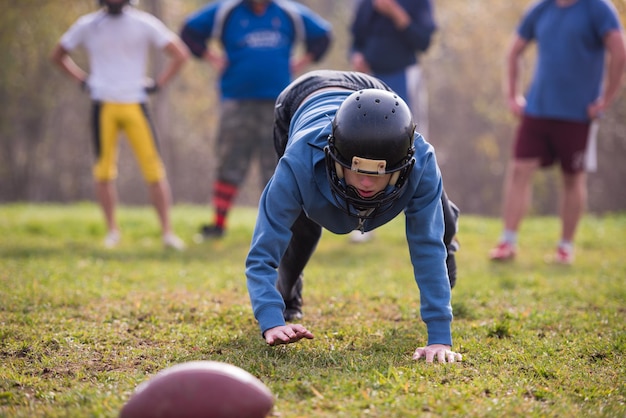Anúncios
Growing up, I vividly remember those sunny Saturday mornings spent on the football field, where dreams were ignited and talents unearthed. I witnessed firsthand how youth football can shape not just athletes, but confident individuals ready to tackle life’s challenges. According to a recent study, approximately 70% of kids who participate in organized sports, like football, develop vital skills such as teamwork and leadership. Testimonials from coaches reveal that structured youth football drills have proven essential for skill acquisition, particularly for beginners eager to excel.
As I reflect on my journey, I realize that the foundation laid during those formative years was crucial. It wasn’t just about winning games; it was about mastering the basics, building camaraderie, and learning discipline. In this article, we’ll delve into effective youth football drills designed specifically for beginners, empowering the next generation of athletes to thrive both on and off the field.
Anúncios
Importance of Youth Football
Youth football programs play a pivotal role in shaping the experiences of young athletes, offering a unique blend of physical fitness and essential life skills. Engaging in football at a young age promotes cardiovascular health, improves strength, and enhances coordination. These physical benefits set the foundation for a healthier lifestyle, helping to combat obesity and other related health issues in children.
Moreover, youth football is not just about individual prowess; it fosters teamwork and camaraderie. Young athletes learn the importance of collaboration, communication, and mutual support as they work together to achieve a common goal. These social skills extend beyond the field, enabling participants to build lasting friendships and develop a sense of belonging.
Participation in youth football also instills discipline and resilience. Young players face the realities of winning and losing, teaching them vital lessons about perseverance and goal-setting. Such experiences can significantly impact their self-esteem and confidence, equipping them with skills that are beneficial throughout their lives.
Anúncios
In summary, the importance of youth football extends far beyond mere competition. It is an invaluable avenue for physical development, social interaction, and personal growth, making it a fundamental component of a young athlete’s journey.
Key Skills for Young Players
Youth football drills serve as a crucial foundation for developing essential skills among young players. Before diving into competitive play, these drills emphasize core abilities that enhance gameplay and foster teamwork. First and foremost, technical skills such as passing, dribbling, and shooting are prioritized. These skills not only improve individual performance but also boost confidence on the field.
In addition to technical prowess, tactical awareness is a vital aspect nurtured through specific drills. Young players learn to understand formations, positioning, and where to move during various game situations. This knowledge is essential for instilling a sense of strategy early on, setting players up for success as they progress.
Furthermore, physical fitness cannot be overlooked. Drills are designed to enhance agility, speed, and endurance. These attributes are fundamental in meeting the demands of the game and ensuring players can perform at their best. Through consistent practice, young athletes develop a strong work ethic and resilience, qualities that extend beyond the field.
Lastly, the importance of communication and teamwork is emphasized through various group drills. Young players learn to collaborate, share responsibility, and support one another. These interpersonal skills are vital not only in football but also in cultivating lifelong relationships on and off the pitch. By focusing on these key skills in youth football drills, programs lay the groundwork for well-rounded athletes ready to excel.
Effective Youth Football Drills

Another valuable drill is “Passing Pairs.” Organize players into pairs, standing about 10 feet apart. They should pass the ball back and forth, focusing on accuracy and proper technique. Encourage them to use both feet, gradually increasing the distance between them to challenge their passing skills.
Lastly, the “Basic Shooting Drill” is crucial for developing striking ability. Position players approximately 15 yards from the goal. Have them take turns shooting on goal, aiming for specific targets inside the net. This drill helps players work on their shooting technique while fostering confidence in front of the goal.
Encouraging Participation
Frequently Asked Questions (FAQ)
Here are some common questions regarding creating a welcoming environment for new players in team sports.
- What are some effective team bonding activities for new players? Team bonding activities can include icebreaker games, trust-building exercises, group outings, and team-building challenges that encourage collaboration and communication.
- How can coaches ensure open communication with all players? Coaches can conduct regular one-on-one check-ins, use feedback forms, and encourage players to express their thoughts during team meetings to foster a culture of openness.
- What role do parents play in supporting new players? Parents can support new players by fostering positive communication with coaches, attending practices and games, and encouraging their children to participate in team activities.
- How can we celebrate small achievements in a team? Celebrating small achievements can be done through weekly recognition announcements, reward systems, team shout-outs during practices, or even celebrating personal milestones like improvements in skills.
- What are some ideas for family game nights? Family game nights can include friendly competitions such as relay races, board games, trivia related to the sport, or barbecue gatherings which encourage bonding within the team community.
Measuring Progress
Additionally, conducting regular skill assessments during practice allows coaches to identify strengths and areas needing focus. Utilizing time trials for sprints or shuttle runs, alongside drills targeting specific skills, can provide measurable data.
Incorporating video analysis is another powerful tool. By recording practice sessions, players can visually assess their techniques and receive constructive feedback, facilitating growth. Regularly reviewing progress with players encourages goal-setting, making training objectives clearer and more attainable.
Explore Effective Training Techniques for Young Athletes
To enhance your understanding of measuring progress and implementing effective training strategies in youth sports, consider this informative resource: Athletic Briefs – Tips for Children’s Sports.